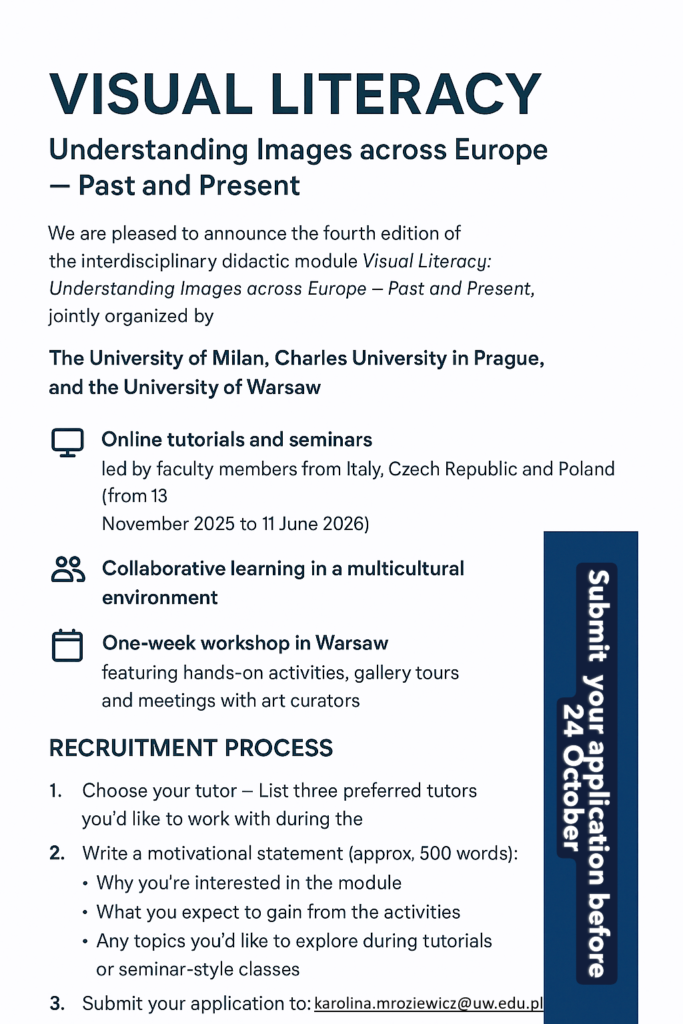
Visual Literacy 2025/2026: Application Deadline Extended
New Deadline: 31 October 2025
Between October 2021 and June 2022 the Institute of Art History of the University of Warsaw together with the Charles University in Prague and the University of Milan implemented – as part of the 4EU + Alliance – the one-year educational module “Visual Literacy: Understanding Images across Europe – Past and Present”. The second and third editions of the module were conducted in 2022/2023 and in 2024/2025. Now the new, forth edition is about to start.
The classes conducted within the framework of the module were taught by lecturers from three partner universities:
- Davide Colombo, PhD (University of Milan)
- Monika Czekanowska-Gutman, PhD (Univeristy of Warsaw)
- Jan Dienstbier, PhD (Charles University)
- Kamila Dworniczak, PhD (University of Warsaw)
- Vendula Fremlová, PhD (Charles University)
- Pavla Gajdošíková, PhD (Charles University)
- Magdalena Herman, PhD (University of Warsaw)
- Giulia Kimberly Colombo, PhD Candidate (University of Milan)
- Karolina Mroziewicz, PhD (University of Warsaw, project coordinator)
- prof. Marie Rakušanová, PhD (Charles University)
- Zuzanna Sarnecka, PhD (University of Warsaw)
- Joanna Smalcerz, PhD (University of Warsaw)
- Zuzana Štefková, PhD (Charles University)
- prof. Giorgio Zanchetti, PhD (University of Milan)
- Giulia Zompa, PhD (University of Milan)
The module consists of an online conversatory class, an online tutorial and in-person field workshop.
In 2025/2026 students can choose between five tutoring programs:
- Multiplied Images: Artistic Practices in the Twentieth Century. The aim of this tutorial, led by Davide Colombo, is to analyse different artistic practices in the twentieth century, which were based on appropriation, collage, photomontage, found footage and re-enactment. Heterogeneous and non-artistic images will be examined along with visual sources. The contamination of low and high models, as well as the circulation of contemporary art and artists’ iconic images in media and popular culture will also be addressed.
- Visual literacy: Between Educational, Artistic and Curatorial Approaches. This is a tutorial conducted by Pavla Gajdošíková and Zuzana Štefková, which will be focused on contemporary art, art education and curating as a form of dialogue and as a way of broadening critical thinking. The students will be researching the contemporary art field and analysing its tendencies, topics or “turns”. On this basis the students will try to develop their own curatorial project together with educational activities (art mediation). The students will be encouraged to their own artistic attempts to understand the attitude of an artist as well.
- Self-Portraits: Artistic Conventions, Meaning, Identity, and Functions from Early Modern through Modern to Contemporary This tutorial, led by Monika Czekanowska-Gutman, introduces students to the development of self-portraits in pre-modern, modern, and contemporary visual culture, including painting, photography, graphic arts, and social media. Emphasis is placed on formal, iconographic, iconological, and semiotic methods of analysis, as well as on the cross-cultural reception of images across different traditions (Jewish, Christian, Arabic, and others). These approaches will equip students to analyze self-portraits critically in terms of how they construct identity, express psychological aspects of personality, and negotiate presence and absence, among other issues.
- Printed Games and Interactive Objects in the 15th–18th centuries. This tutorial, led by Magdalena Herman, explores how printed games of the 15th–18th centuries were created, perceived, and functioned as interactive, social, and material artifacts. The course will focus primarily on selected examples of card, board, and book games, examining the relationships between these objects, their creators, and players. We will also consider how games and gameplay were represented, analyzing their role in the early modern iconography and the visual language they themselves embodied.
- Materiality of Colour and Practices in Painters’ Workshops of the Late Middle Ages and Early Modernity. This tutorial, conducted by Karolina Mroziewicz, will explore the physical properties of colours, the economic and cultural value of pigments, their trade routes, and their application in 15th- and 16th-century painters’ workshops. Students will engage in hands-on experiments with paint production and reflect on the conditions that rendered the pre-modern colour palette legible, meaningful, and valuable to contemporary viewers. They will also experience first-hand the challenges and limitations of reconstructing late medieval and early modern paint recipes.
The presentation with practical information about the upcoming edition of the project can be downloaded here.
The classes begin in November 2025.